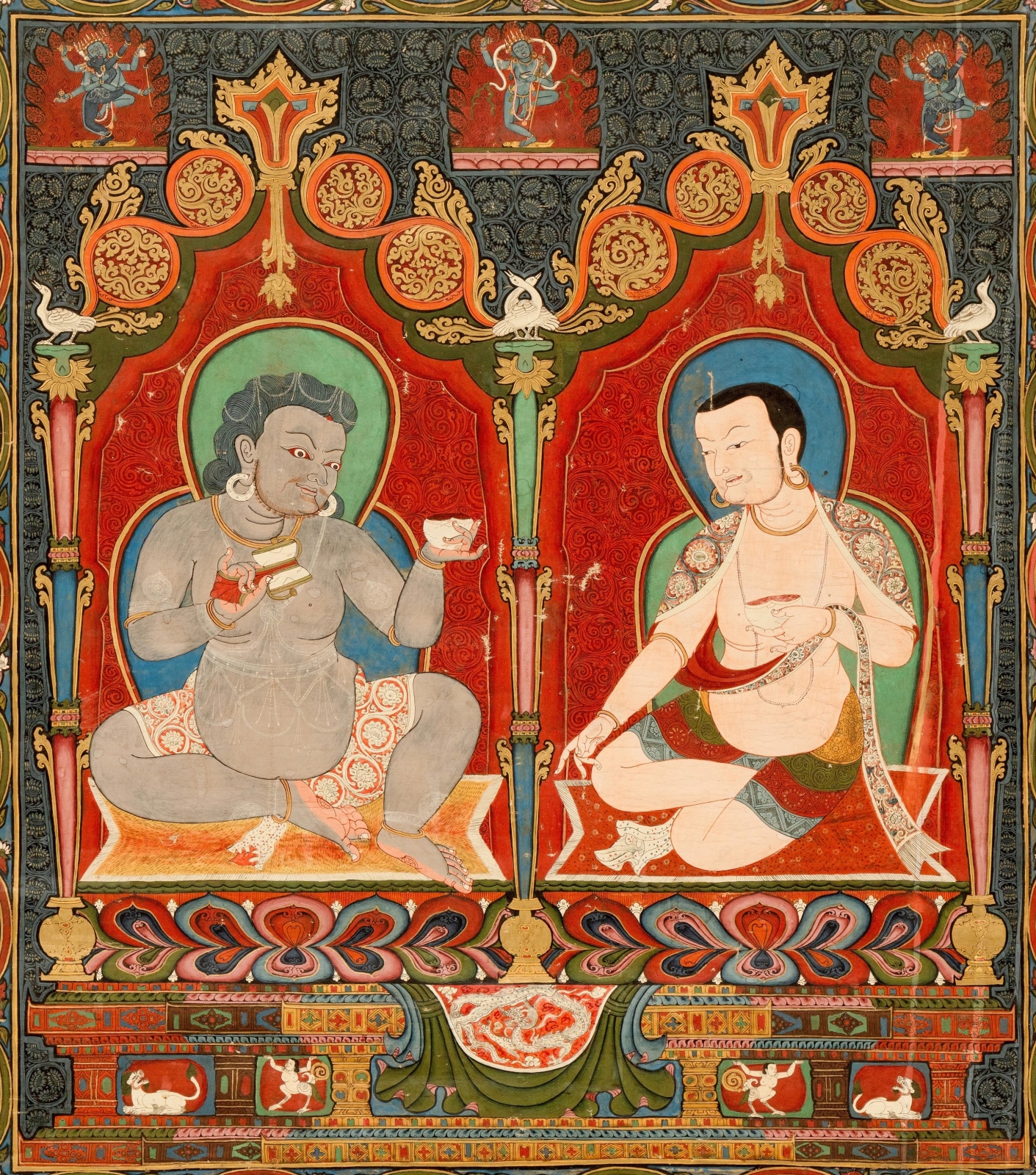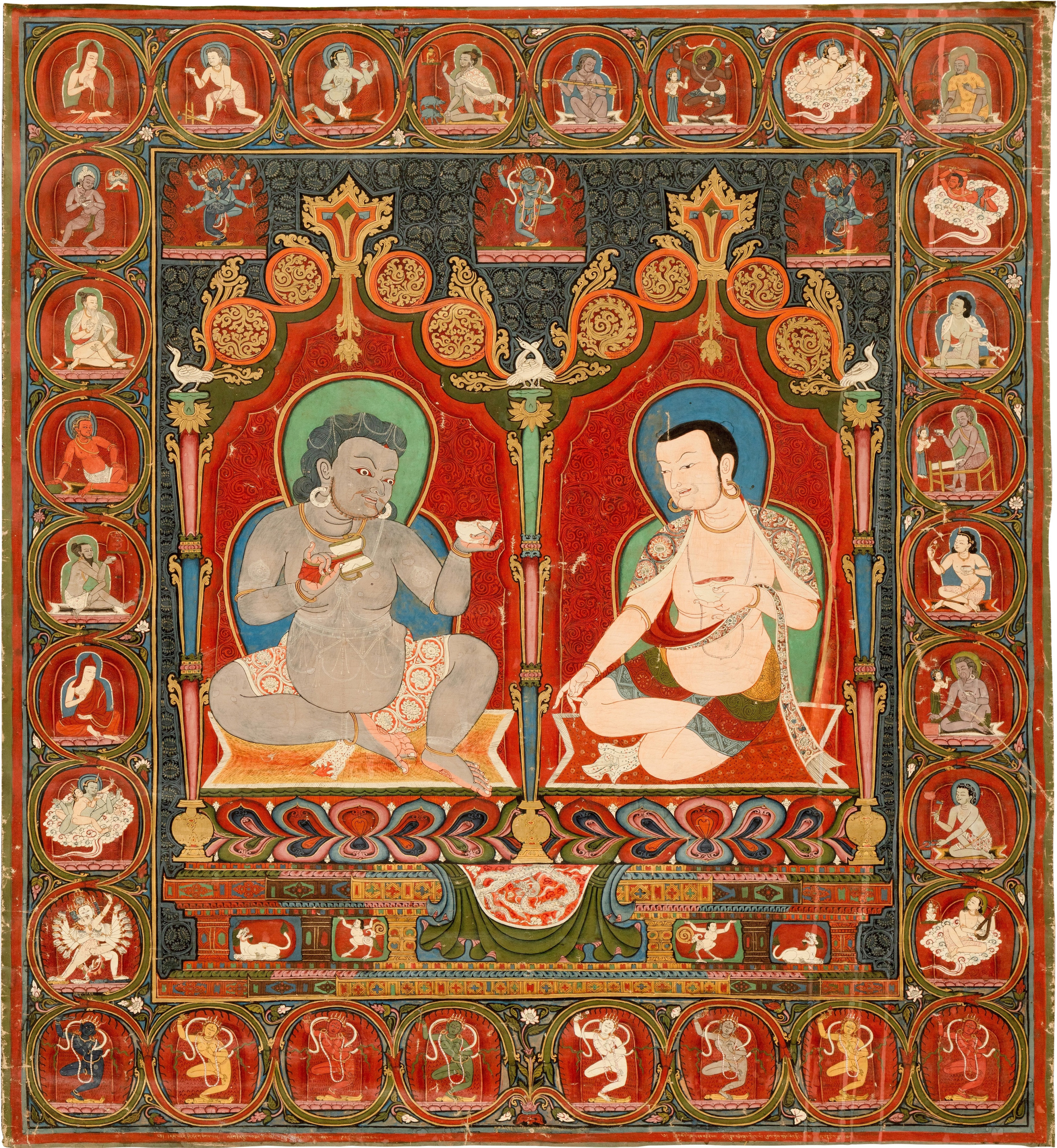
Provenance:
Swiss Private Collection
Koller, Zurich, November 20 and 21, 1992, no. 5
European Private Collection
Published:
Jörg Heimbel and David Jackson, “Portraying the Lineage Masters of the Path with its Fruit: Lowo Khenchen’s Description of Ngorchen’s Commission,” in Schaeffer et al., Histories of Tibet, Wisdom Publications, 2023, pp. 55-95, pl. 5
The two mahasiddhas are seated beneath golden arches (torana) topped with flaming jewels motifs (triratna) on a large double throne, with Damarupa on the left holding his eponymous skull drum (damaru) in his right hand and skull cup (kapala) in his left, and Avadhutipa gesturing with his right hand and holding a skull cup in his left. Mahasiddhas and panditas are depicted in the upper and side registers together with the meditation deity Vairochana Hevajra lower left accompanied by his entourage of the eight dancing Phan pa goddesses in the lower register.
The painting is framed with what is likely the original blue silk fishtail mounts with two floral-pattered silk veils, and is inscribed in gold characters in the blue border beneath the lower register: grub chen budha shri pa’i thugs kyi dgongs pa yongs su rdzogs par gyur cig: “May the intentions of Drupchen Buddhashri be completely fulfilled;” with invocations in the red border beneath identifying the two principal figures.
The work is one of a series of thangkas depicting the lineage of Lamdre masters commissioned by Ngorchen Kunga Zangpo (1382-1456) in memory of his guru Buddhashri (1339-1420): three others are known from the set of thangkas, each with a more or less similar inscription in gold along the lower register, see Heimbel and Jackson, op. cit., p. 60, where the authors suggest that Ngorchen’s commission of this set of paintings was made while he was still at Sakya monastery shortly after the death of his guru in 1420, thus dating the paintings to circa 1420, ibid., p. 58. The series includes the first painting in the set, formerly in the Stella Kramrisch Collection and now in the Philadelphia Museum of Art, portraying the primordial Buddha Vajradhara, progenitor of the Lamdre teaching, ibid., pl. 3 and Jackson, The Nepalese Legacy in Tibetan Painting, New York, 2010, fig. 8.4. Another from the series, depicting Sonam Tsemo (1142-1182) and Dragpa Gyaltsen (1147-1216) is in the Museum of Fine Arts, Boston, Heimbel and Jackson, op. cit., pl. 6. The third, depicting Virupa and Krishnapa, is in the Mr. and Mrs. Gilbert H. Kinney Collection and currently exhibited at The Metropolitan Museum of Art, Heimbel and Jackson, op. cit., pl. 4 and Kurt Behrendt, Mandala: Mapping the Buddhist Art of Tibet, New York, 2024, cat. no 75.
The Tibetan monastery of Ngor was founded in 1429 by the Sakya master Kunga Zangpo (1382-1456) in a remote area of Tsang Province southwest of Shigatse. Ngorchen Kunga Zangpo insisted on strict monastic practice at the new monastery, to reestablish the core tenets of Sakya order teaching. The monastery became a renowned center of esoteric instruction, attracting monks from all over Tibet hoping to receive initiation from Ngorchen, who was revered as an emanation of the primordial Buddha Vajradhara. Some of the finest fifteenth-century Tibetan thangkas were commissioned by Ngorchen and painted in Sakya and Ngor monasteries by Newar artists from the Kathmandu Valley. An account from the Ngor annals tells of six Newar artists arriving at the monastery just as Kunga Zangpo had ordered commemorative mandalas to be painted in honor of his teachers Buddhashri (1339-1420) and Sabzang Pakpa Zhönnu Lodrö (1346–1412). The itinerant artists were said to have refused work on their journey into Tsang as they felt miraculously impelled to the isolated monastery, where Ngorchen entrusted them with the commission. The Ngor and Sakya monastery paintings that survive are evidence of the quintessential Nepalese painting style in their mastery of bold color and form and exquisite animated detail. The paintings remain a testament to the close relationship between the patrons of Sakya order monasteries and the finest Newar artists of the day.

